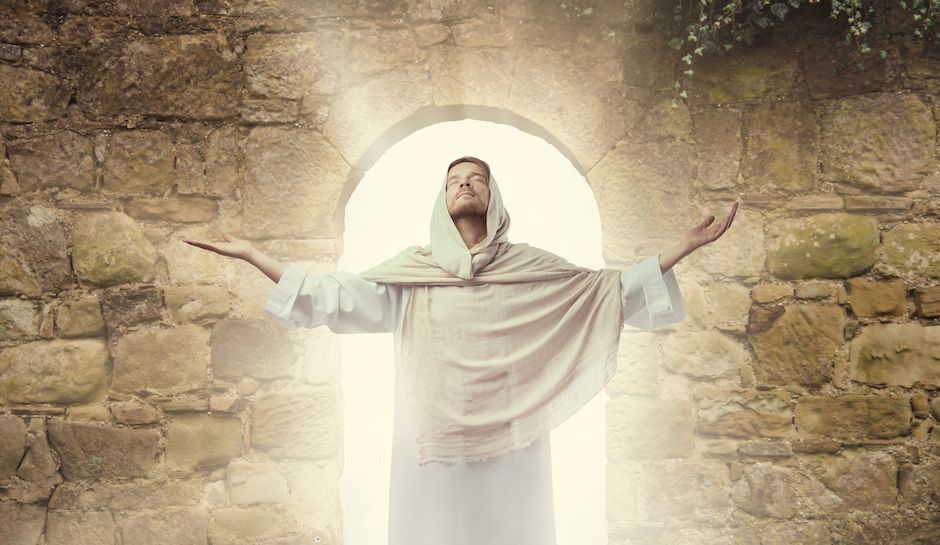
So, here’s the biggie—the core of the whole matter!
-
Did Jesus really rise from the dead?
-
Is there resurrection evidence?
-
What makes this event so important?
In a nutshell, the New Testament is based on Jesus Christ and the power of his resurrection. Since the basis of biblical Christianity is Jesus Christ and His resurrection, then the historical truth about his life, death, and resurrection are of the utmost importance. As Paul declared in his letter to the Corinthians:
 And if Christ has not been raised, our preaching is useless and so is your faith. More than that, we are then found to be false witnesses about God, for we have testified about God that he raised Christ from the dead.1
And if Christ has not been raised, our preaching is useless and so is your faith. More than that, we are then found to be false witnesses about God, for we have testified about God that he raised Christ from the dead.1
The best way to investigate the resurrection of Jesus is to test the historical evidence without bias. In order to be fair, we need to judge the evidence in the same way we would for any other historical event. Based on standard courtroom rules, consistent testimony from multiple credible witnesses is considered the strongest form of evidence. If we can find consistent testimony from multiple witnesses in credible historical accounts, this would be considered sufficient evidence today in the court of law.
In fact, we do find multiple eyewitness testimonies regarding the resurrection of Jesus. In his letter to the Corinthian church, Paul established the following:
For what I received I passed on to you as of first importance: that Christ died for our sins according to the Scriptures, that he was buried, that he was raised on the third day according to the Scriptures, and that he appeared to Peter, and then to the Twelve. After that, he appeared to more than five hundred of the brothers at the same time, most of whom are still living, though some have fallen asleep.2
Studies of New Testament manuscripts indicate that this was a very early creed of the Christian faith, written within a few years of the death of Jesus Christ. Therefore, it’s dramatic that Paul ends the passage with “most of whom are still living.” Paul was inviting people to check out the facts. He wouldn’t have included a statement like that if he was trying to hide a conspiracy, hoax, or legend.
The resurrection of Jesus was also declared in numerous other accounts, including the appearance of Jesus to Mary Magdalene,3 to other women,4 to Cleopas and his companion,5 to eleven disciples and others,6 to ten apostles and others (excluding Thomas),7 to the apostles (including Thomas),8 to seven apostles,9 to the disciples,10 and to the apostles on the Mount of Olives.11 The ultimate test of credibility for these eyewitnesses was that many of them faced horrible deaths for their eyewitness testimony. These witnesses knew the truth! What could they possibly gain by dying for a lie? The evidence speaks for itself: these weren’t just religious fanatics dying for a religious belief, these were followers of Jesus dying for a historic event—His resurrection—which, according to many prophecies written throughout the Old Testament, established him as the Christ―the Son of God.
 When we consider the evidence, the resurrection of Jesus Christ is one of the most supported facts of all time. After rising from the dead and before ascending back into heaven, Jesus was seen by hundreds of eyewitnesses, many of whom were willing to suffer and died unflinchingly for their testimony.12 This established fact attests to the sincerity of their faith and strongly rules out deception on their part. In fact, all but one of the New Testament writers were executed for proclaiming and defending Christ’s resurrection (John alone was spared, but forced into exile by the Roman Emperor Titus Flavius Domitianius).
When we consider the evidence, the resurrection of Jesus Christ is one of the most supported facts of all time. After rising from the dead and before ascending back into heaven, Jesus was seen by hundreds of eyewitnesses, many of whom were willing to suffer and died unflinchingly for their testimony.12 This established fact attests to the sincerity of their faith and strongly rules out deception on their part. In fact, all but one of the New Testament writers were executed for proclaiming and defending Christ’s resurrection (John alone was spared, but forced into exile by the Roman Emperor Titus Flavius Domitianius).
The New Testament’s eyewitnesses either saw what they claimed to see or they didn’t, plain and simple. Either they interacted with the resurrected Jesus or they didn’t.
These men clung to their testimonies even to their brutal deaths at the hands of their persecutors, in spite of being given every opportunity to recant. Why would so many men knowingly die for a lie? They had nothing to gain by lying, but everything to lose. Their testimonies are credible.
In addition to the disciples experiencing what they claimed to be resurrection appearances, there were even a few skeptics who believed Jesus had appeared to them alive after the crucifixion. Most biblical scholars today agree that Paul was a skeptic and even a persecutor of the people of the early Christian church prior to experiencing a post-resurrection appearance. Most scholars also agree that James was a skeptic prior to experiencing what he called a post-resurrection appearance.
Paul’s experience caused him to immediately change from a nasty persecutor of Christianity to one of its most aggressive advocates. He claimed that this change came only after personally interacting with the resurrected Christ, and he willingly suffered and died for his testimony.13

Prior to Jesus’ resurrection, his very own brother, James, was a skeptic.14 His experience of a post-resurrection appearance is reported within five years of Jesus’ crucifixion.15 After personally interacting with the risen Christ, James became a leader of the Christian church in Jerusalem.16 James willingly died for his belief that Jesus was the Messiah who died and rose again.17
How could anyone have the endurance to suffer horrifically―and ultimately die―for a lie? And yet, many of Jesus’ disciples, followers, and even skeptics did endure this suffering, knowing that death was imminent because they truly believed they had encountered the risen Christ! Their Testimonies are Credible.
In addition to the eyewitness accounts of the resurrected Jesus, it’s interesting to note that most biblical scholars agree that Christ’s tomb was empty. Consider the following:
- The Jerusalem Factor: Since Jesus was publicly executed and buried in Jerusalem, it would have been impossible for Christianity to begin in Jerusalem while the body was still in the tomb. Christ’s enemies in the Jewish leadership and the Roman government would only have to exhume the corpse and publicly display it for the hoax to be shattered.
- The Jewish Response: Rather than point to an occupied tomb, the Jewish leaders accused Christ’s disciples of stealing his body. Wouldn’t this strategy seem to establish that there was, in fact, a missing body?18
- The Women’s Testimony: In all four biblical accounts of the empty tomb, women are listed as the primary witnesses. This would be an odd invention since, in both Jewish and Roman cultures, women were not esteemed and their testimony was not admissible.
Lee Strobel is a Yale-educated, award-winning journalist. As an atheist, he decided to compile a legal case against Jesus Christ and prove him to be a fraud by the weight of evidence he sought to gather. As Legal Editor of the Chicago Tribune, Strobel’s area of expertise was courtroom analysis. To make his case against Christ, Strobel cross-examined a number of Christian authorities, recognized experts in their own fields of study, including Doctors of Philosophy from such prestigious academic centers as Cambridge, Princeton, and Brandeis. He conducted his examination with no religious bias, other than his predisposition to atheism. 
Remarkably, after compiling and critically examining the evidence for himself, Strobel became a Christian. Stunned by his findings, he organized the evidence into a book entitled, The Case for Christ, which won the Gold Medallion Book Award for excellence. Strobel asks one thing of each reader―remain unbiased in your examination of the evidence. “In the end, judge the evidence for yourself, acting as the lone juror in the case for Christ…”19
More recently, Strobel authored The Miracles of Christ and others, in which he critically examines evidence and follows where it leads.
- 1 Corinthians 15:14-15.
- 1 Corinthians 15:3-6.
- John 20:10-18.
- Matthew 28:8-10.
- Luke 24:13-32.
- Luke 24:33-49.
- John 20:19-23.
- John 20:26-30.
- John 21:1-14.
- Matthew 28:16-20.
- Luke 24:50-52 and Acts 1:4-9.
- Historical sources: Luke, Clement of Rome, Polycarp, Ignatius, Dionysius of Corinth, Tertullian, Origen.
- Historical sources: Paul, Luke, Clement of Rome, Polycarp, Tertullian, Dionysius of Corinth, Origen.
- Mark, John.
- 1 Corinthians 15:7.
- Paul, Luke.
- Historical sources: Josephus, Hegesippus, Clement of Alexandria.
- Historical sources: Matthew, Justin, Tertullian.
- Lee Strobel, The Case For Christ, Grand Rapids: Zondervan, 1998.
Want More?
https://www.dontbeleftbehind.org/
Sources: Randall Niles, www.AllAboutGOD.com, www.GotQuestions.org, and www.AllAboutTheJourney.org.










